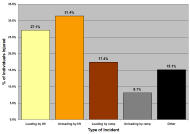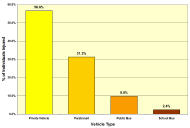K. Ashley Rotko, BS, Thomas Songer, PhD, Shirley Fitzgerald, PhD, Patricia Karg, MS
Department of Rehabilitation Science and Technology,
University of Pittsburgh
ABSTRACT
Little is known about the injury risk to wheelchair users who use motor vehicle transportation. This study was designed to quantify the injury risk to wheelchair users while loading and unloading from a motor vehicle. To identify this information, a 12-page survey was completed by 336 wheelchair users. The results showed that most loading and unloading injuries occurred while the subject was using a lift and a private vehicle. In addition, it was shown that these events had higher injury rates, when compared to the injury rates of both crash and non-crash incidents. These findings suggest that research and training efforts focused on private vehicle and lift use may be beneficial.
KEYWORDS
Wheelchair, Transportation, Injury, Lift, Ramp
BACKGROUND
In recent years transportation needs for individuals who use wheelchairs have begun to increase. This is partly due to the passage of the Americans with Disabilities Act (ADA), which prohibits the discrimination of people with disability, and allows for the increased participation by these individuals in employment, social and other activities. 1 In order to improve the transportation safety of individuals who use wheelchairs, it is important to identify where, and to what extent injury risk exists. It is necessary to consider all areas of transportation use, not only when the vehicle is in motion (crashes, emergency maneuvering), but also while it is stationary (entering/exiting via lift or ramp). An examination of the National Electronic Injury Surveillance System (NEISS) was completed between the years of 1991-95 to obtain data on injuries to wheelchair users involving a motor vehicle. This information showed that approximately 1,500 wheelchair users were either injured or killed each year. While the majority 35% were injured due to improper or no securement, nearly 19% were injured due to lift malfunction and 6% from falling on/off of a ramp. 2 This demonstrates that 25% of all injuries to wheelchair users in a transportation situation occurred while the individual was either entering or exiting the vehicle.
RESEARCH QUESTION
The purpose of this paper is to quantify the injury risk to wheelchair users while loading and unloading from a motor vehicle, as well as describe the characteristics of those individuals injured in this nature. These data can provide descriptive information to supplement existing research, policy, standards, and training, in addition to suggesting future areas of study for wheelchair transportation safety.
METHODS
This study consists of 336 wheelchair users who self-identified in a telephone screening survey, that they 1) use a wheelchair as their primary means of mobility and 2) at least some point in time remain in their wheelchair during transportation use. Once eligibility was determined, a 12 page survey, consisting of questions regarding demographic characteristics, wheelchair type, transportation mode, and the occurrence of an injury while using a motor vehicle within the past 3 years, was mailed. All subjects provided informed consent. Descriptive statistics, chi-square and t-test analysis was completed using SPSS statistical software.
RESULTS
At the completion of the project 336 wheelchair users completed and returned the survey. The sample population was 46.7% male, with a mean age of 42.7 ± (14.6) years. 67.7% of the subjects had a non-progressive disability (spinal cord injury, cerebral palsy, spina bifida), as compared to 32.3% with a progressive disability (multiple sclerosis, muscular dystrophy). 66.7% of the population reported using a power wheelchair, while 33.3% reported using a manual wheelchair as their primary means of mobility.
 |
In regard to injuries occurring while entering or exiting from the vehicle, 53 wheelchair users (15.8%) of the population reported that they were injured in this manner. These individuals stated that during a period of 3 years, a total of 99 unique incidents that resulted in some type of injury occurred. It should be noted that the extent and specific cause of the injury was not identified in this study. Of those 99 loading and unloading incidents, 86 were reported in extended detail, meaning that detail was provided regarding the vehicle type and manner in which the injury occurred. These data show that 31.3% of injuries occurred while unloading by a lift, 27.1% occurred while loading by a lift, 17.6% occurred while loading by a ramp, 8.2% occurred by unloading from a ramp and 15.3% occurred in another manner. This data can also be stated as 58.4% of all loading/unloading injuries occurred while using a lift and 25.8% occurred while using a ramp.
The demographic characteristics of those injured in a loading/unloading incident are similar to those who were not injured in this manner. There was no significant difference between the two groups. The characteristics of both groups are as followed: Gender (Injured: 49.1% male; Not Injured: 46.3% male); Mean Age (Injured: 39.3 ± (14.6) years; Not Injured: 43.3 ± (14.6) years); Disability Type (Injured: 66.7% non-progressive, 33.3% progressive; Not Injured: 67.9% non-progressive, 32.1% progressive); Wheelchair Type (Injured: 61.7% power, 38.3% manual; Not Injured: 67.5% power, 32.5% manual).
 |
The type of motor vehicle involved in this kind of injury was also examined. Subjects reported that 56.6% of all loading/unloading injuries occurred in a privately owned vehicle, 31.3% occurred in paratransit vehicles, 9.8% occurred in public buses and 2.4% occurred while the passenger was entering or exiting a school bus.
Finally, analysis was completed to compare the injury rate of those injured in a loading/unloading event to those injured in either a motor vehicle crash or non-crash incident (emergency maneuvering). As stated above the data showed that 15.8% of the population (n=53) were injured in a total of 99 loading/unloading incidents. This percentage is similar to those injured in a non-crash incident, where 15.7% (n=52) were involved in a total of 105 events. However, when comparing these events to those where an injury occurred due to a motor vehicle crash, the percentages are higher. Only 6.0% (n=20) of the population was injured in a total of 21 motor vehicle crashes within the past 3 years. These trends can also be seen when examining the exposure to transportation. Loading/unloading events had higher injury rates, when compared to the injury rates of both non-crash incidents and motor vehicle crashes (loading/unloading injuries: 43.1 injuries per 100,000 miles traveled; non-crash incidents: 31.8 injuries per 100,000 miles traveled; motor vehicle crashes: 3.6 injuries per 100,000 miles).
| % of Individuals Injured | # of Unique Injuries | Injury Rate per 100,000 Miles | |
|---|---|---|---|
| Loading or Unloading Injury | 15.8% (n=53) |
99 |
43.1 |
| Injury from Non-crash Incident | 15.7% (n=52) |
105 |
31.8 |
| Injury from Crash | 6.0% (n=20) |
21 |
3.6 |
DISSCUSION
With the increasing number of wheelchair users utilizing motor vehicle transportation and the limited research that has been completed in the area of injury risk to these individuals, it is important to identify where the transportation safety risks exists. The main purpose of this paper was to quantify the injury risk associated with loading and unloading as well as describe the characteristics of those individuals who were injured in such a manner.
The data demonstrates that 44% of all reported injuries in this survey study resulted either from entering or exiting a motor vehicle. This number, along with the injury rate of 43.1 injuries per 100,000 miles, emphasizes the need for further investigation in this area.
Another point of interest includes the increased percentage of injuries that occurred while using a lift (58.4%), as compared to those that occurred while using a ramp (25.8%). These data suggest that the use of a ramp to enter and exit a vehicle may be safer. While further research is required to identify the severity and the exact cause of the injury, some suggestions can be made to improve the safety of using a lift. Reexamination of the lift design and standards, increased safety precautions while using the lift, and better user and driver training may be beneficial.
Finally, the vehicle type involved in loading and unloading injuries is also a concern. The data shows that the majority of injuries occurred in a privately owned vehicle (56.6%), while 43.4% occurred in a public vehicle. It should be noted however, that most injuries taking place in public transportation did occur in a paratransit vehicle (31.3% of the total reported injuries). It is hypothesized that research and training efforts focused on private and paratransit vehicles may be beneficial.
This study is representative of the experiences of a convenience sample of 336 wheelchair users, and required the recall of specific events across a 3 year period, for these reasons bias may be present in the reporting and analysis of the injury occurrence. Responses were received from subjects across the United States and reflect numerous disabilities. The responses from a random sample of wheelchair users may differ.
In summary, this analysis found that transportation injury risk to wheelchair users exists while entering or exiting the motor vehicle. In addition, the results suggest that research and training emphasis should be placed on the use of lifts and private vehicles.
REFERENCES
- (ATBCB), Americans with Disabilities Act (ADA) Accessibility Guidelines for Transportation. 1991.
- National Highway Traffic Safety Administration. Wheelchair Users Injuries and Deaths Associated with Motor Vehicle Related Incidents. Research Note. Washington, DC: National Center for Statistics & Analysis, September 1997.
ACKNOWLEDGEMENTS
This study was funded by the National Institute on Disability and Rehabilitation Research (NIDRR) and the Rehabilitation Engineering Research Center (RERC) on Wheelchair Transportation, grant # H133E010302. The opinions expressed herein are those of the authors and are not necessarily reflected of NIDRR opinions.
K. Ashley Rotko
Department of Rehabilitation Science and Technology
Forbes Tower – Suite 5044
Atwood and Sennott Streets
Pittsburgh, PA 15260
(412) 383-6884
(412) 383-6597 (fax)
karst55@pitt.edu